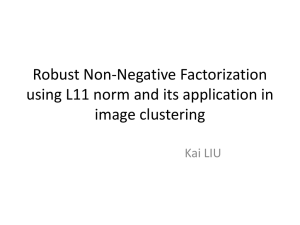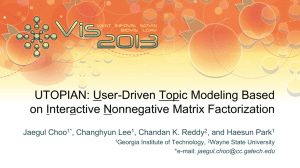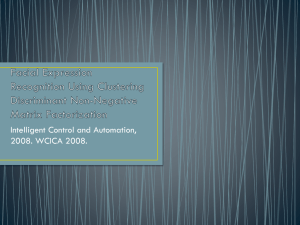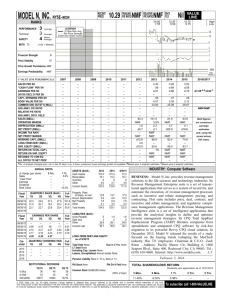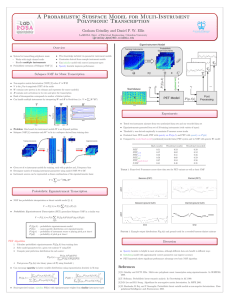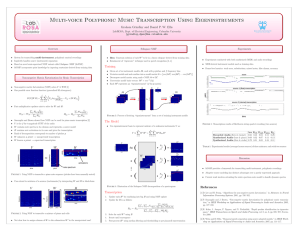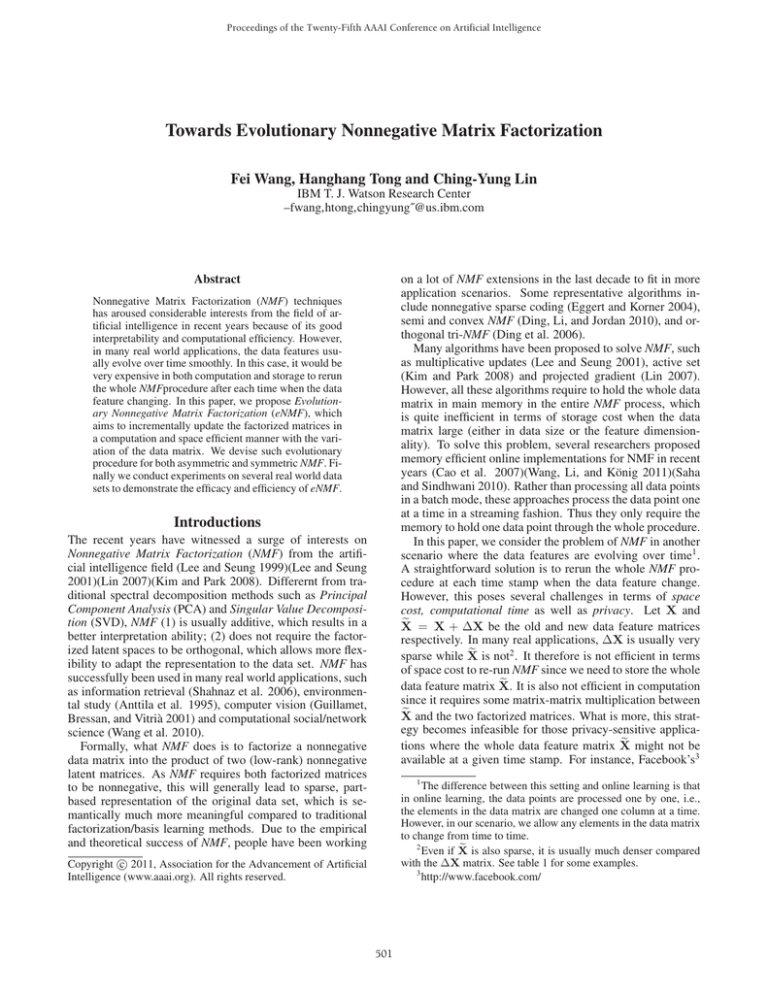
Proceedings of the Twenty-Fifth AAAI Conference on Artificial Intelligence
Towards Evolutionary Nonnegative Matrix Factorization
Fei Wang, Hanghang Tong and Ching-Yung Lin
IBM T. J. Watson Research Center
–fwang,htong,chingyung˝@us.ibm.com
on a lot of NMF extensions in the last decade to fit in more
application scenarios. Some representative algorithms include nonnegative sparse coding (Eggert and Korner 2004),
semi and convex NMF (Ding, Li, and Jordan 2010), and orthogonal tri-NMF (Ding et al. 2006).
Many algorithms have been proposed to solve NMF, such
as multiplicative updates (Lee and Seung 2001), active set
(Kim and Park 2008) and projected gradient (Lin 2007).
However, all these algorithms require to hold the whole data
matrix in main memory in the entire NMF process, which
is quite inefficient in terms of storage cost when the data
matrix large (either in data size or the feature dimensionality). To solve this problem, several researchers proposed
memory efficient online implementations for NMF in recent
years (Cao et al. 2007)(Wang, Li, and König 2011)(Saha
and Sindhwani 2010). Rather than processing all data points
in a batch mode, these approaches process the data point one
at a time in a streaming fashion. Thus they only require the
memory to hold one data point through the whole procedure.
In this paper, we consider the problem of NMF in another
scenario where the data features are evolving over time1 .
A straightforward solution is to rerun the whole NMF procedure at each time stamp when the data feature change.
However, this poses several challenges in terms of space
cost, computational time as well as privacy. Let X and
= X + ΔX be the old and new data feature matrices
X
respectively. In many real applications, ΔX is usually very
is not2 . It therefore is not efficient in terms
sparse while X
of space cost to re-run NMF since we need to store the whole
It is also not efficient in computation
data feature matrix X.
since it requires some matrix-matrix multiplication between
and the two factorized matrices. What is more, this stratX
egy becomes infeasible for those privacy-sensitive applica might not be
tions where the whole data feature matrix X
available at a given time stamp. For instance, Facebook’s3
Abstract
Nonnegative Matrix Factorization (NMF) techniques
has aroused considerable interests from the field of artificial intelligence in recent years because of its good
interpretability and computational efficiency. However,
in many real world applications, the data features usually evolve over time smoothly. In this case, it would be
very expensive in both computation and storage to rerun
the whole NMFprocedure after each time when the data
feature changing. In this paper, we propose Evolutionary Nonnegative Matrix Factorization (eNMF), which
aims to incrementally update the factorized matrices in
a computation and space efficient manner with the variation of the data matrix. We devise such evolutionary
procedure for both asymmetric and symmetric NMF. Finally we conduct experiments on several real world data
sets to demonstrate the efficacy and efficiency of eNMF.
Introductions
The recent years have witnessed a surge of interests on
Nonnegative Matrix Factorization (NMF) from the artificial intelligence field (Lee and Seung 1999)(Lee and Seung
2001)(Lin 2007)(Kim and Park 2008). Differernt from traditional spectral decomposition methods such as Principal
Component Analysis (PCA) and Singular Value Decomposition (SVD), NMF (1) is usually additive, which results in a
better interpretation ability; (2) does not require the factorized latent spaces to be orthogonal, which allows more flexibility to adapt the representation to the data set. NMF has
successfully been used in many real world applications, such
as information retrieval (Shahnaz et al. 2006), environmental study (Anttila et al. 1995), computer vision (Guillamet,
Bressan, and Vitrià 2001) and computational social/network
science (Wang et al. 2010).
Formally, what NMF does is to factorize a nonnegative
data matrix into the product of two (low-rank) nonnegative
latent matrices. As NMF requires both factorized matrices
to be nonnegative, this will generally lead to sparse, partbased representation of the original data set, which is semantically much more meaningful compared to traditional
factorization/basis learning methods. Due to the empirical
and theoretical success of NMF, people have been working
1
The difference between this setting and online learning is that
in online learning, the data points are processed one by one, i.e.,
the elements in the data matrix are changed one column at a time.
However, in our scenario, we allow any elements in the data matrix
to change from time to time.
2
is also sparse, it is usually much denser compared
Even if X
with the ΔX matrix. See table 1 for some examples.
3
http://www.facebook.com/
c 2011, Association for the Advancement of Artificial
Copyright Intelligence (www.aaai.org). All rights reserved.
501
problem we need to solve is
2
min X − FG privacy policy prohibits the user to keep the downloaded
data longer than 24 hours. So, if a data analyst wants to track
the community structure on the daily-base, s/he would only
have the access to the data feature within a 24 hour window.
For evolutionary data, one common assumption is that the
data features evolve smoothly over time (Chi et al. 2007),
i.e., the norm of the difference between the data feature matrices at two consecutive time stamps is very small. Based on
this assumption, we develop a novel Evolutionary Nonnegative Matrix Factorization (eNMF) algorithm in this paper,
where we assume that the factorized matrices also evolve
smoothly over time. Instead of minimizing a new similar
objective on the evolved feature matrix, eNMF minimizes
an upper bound of the objective, and we devise an efficient
projected gradient method to solve the problem. Finally
we conduct experiments on several real world data sets to
demonstrate the efficacy and efficiency of eNMF.
It is worthwhile to highlights several aspects of eNMF.
F0,G0
F
F0,
G0
F
(1)
where A2F = tr A A is the square of the matrix
Frobenius norm. This problem can be solved via multiplicative updates (Lee and Seung 2001), active set method (Kim
and Park 2008) or projected gradient (Lin 2007) method.
Now suppose there is a small on variation on X so that X
becomes
= X + ΔX
X
(2)
n×d
∈R
is also nonnegative. Our goal is to factorize
and X
into the product of two nonnegative matrices F
∈ Rn×k
X
d×k
and G ∈ R
, then we need to solve the following optimization problem
2
− FG (3)
min X
• eNMF is space efficient. eNMF only needs to hold the
difference matrix, which is usually much sparser due to
the smoothness assumption.
We assume
sented as
2
ΔXF
G
can be repreis very small, and F,
=
F
=
G
• eNMF is computationally efficient. One major computational cost in NMF the matrix-matrix multiplications. Our
eNMF achieves computational savings by using a much
sparser matrix in such matrix-matrix multiplications.
F + ΔF
(4)
G + ΔG
(5)
Bringing Eq.(4) and Eq.(5) into problem (3), we can get that
2
2
G
X − F
= X + ΔX − (F + ΔF) (G + ΔG) F
F
2
= X + ΔX − FG − ΔFG − FΔG − ΔFΔG (6)
• eNMF is privacy-friendly. eNMF does not need to know
the exact data feature matrix. It only requires the factorized matrices at the initial time stamp and the difference data feature matrix. This is particularly useful for
those privacy-sensitive applications, e.g., the data feature
is only available for a short time window.
F
and the constraint here is that
= F + ΔF 0
F
• eNMF can be applied to different types of data. We
developed two instantiations for both traditional asymmetric NMF(where the feature matrix is rectangular) and
symmetric NMF(where the feature matrix is symmetric
square, e.g., data similarity matrix).
=
G
G + ΔG 0
(7)
(8)
For matrix Frobenius norm, we have the following triangle
inequality
X + ΔX − FG − ΔFG − FΔG − ΔFΔG F
X − FG + ΔX − ΔFG − FΔG − ΔFΔG The rest of this paper is organized as follows. Section 2
introduces the problem formulation and algorithm details.
The experimental results are presented in Section 3, followed by the conclusions in Section 4.
F
F
In our evolutionary setting, we already got the optimal F and
G by solving problem (1), thus X − FG F is already
minimized. In order to minimize the objective of problem
(3), we propose to solve the following optimization problem
2
minΔF,ΔG ΔX − ΔFG − FΔG − ΔFΔG F
s.t.
F + ΔF 0, G + ΔG 0
(9)
The Algorithm
In this section we will introduce our eNMF algorithm in detail. First we will introduce the basic notations that will be
used throughout this paper and problem formulation.
This is an optimization problem with box constraints, and
we propose to apply Projected Gradient (PG) (Lin 2007)
method to solve it.
Problem Formulation
Suppose we have a nonnegative matrix X ∈ R
, and we
want to factorize it into the product of two nonnegative matrices F ∈ Rn×k and G ∈ Rd×k (usually k min(d, n))
under some loss. In this paper we will concentrate on the
Frobenius norm loss as it is one of the most popular loss
forms, the algorithms under other loss such as KullbackLeighbler divergence (Lee and Seung 2001), β-divergence
(Févotte and Idier 2010) and Bregman divergence (Dhillon
and Sra 2005) can be derived similarly. The optimization
n×d
Projected Gradient
In this section we will introduce how to make use of PG to
solve problem (9). For notational convenience, we introduce
a box projection operator PB [A] as
Aij if Aij Bij
(PB [A])ij =
(10)
Bij otherwise
502
obtained ΔF or ΔG is sparse, therefore the storage cost can
be further reduced by only storing the nonzero elements.
For computational complexity, as both eNMF and NMF
need to evaluate the function objective value (in Armijo rule)
when applying PG, the main difference would lie in the evaluation of the function gradient. Suppose that we have m and
m̂ non-zero elements in the matrices X + ΔX and ΔX respectively, then the time cost for eq. (14) and Eq. (15) is
O(m̂k) + O(nk 2 ) + O(dk 2 ). In contrast, the time complexity for computing the gradient for the original NMF is
O(mk) + O(nk 2 ) + O(dk 2 ). In many real applications, the
matrix ΔX is usually much more sparser than the matrix
X + ΔX (i.e., m̂ m). Moreover, since k n, l < m,
O(mk) is dominant term of the time complexity for the original NMF. Therefore, we would expect that the proposed
algorithm is much more efficient in computation compared
with the original NMF.
Algorithm 1 Projected Gradient
(0)
Require: 0 < β < 1, 0 < σ < 1. Initialization A .
Ensure: A(0) B
for k = 1, 2, · ·· do
A(k) = PB A(k−1) − αk ∇f A(k−1)
where αk = β tk , and tk is the first nonnegative integer
for which
f A(k) −f A(k−1) σ ∇f A(k−1) , A(k) −Ak−1) (12)
end for
Then the PG method for solving the problem
min f (A)
AB
(11)
can be presented in Algorithm 1, where ·, · is the sum of
elementwise multiplication, and the rule for determining the
step size in Algorithm 1 is usually referred to as the Armijo
rule (Bertsekas 1999).
Now let us return to problem (9). If we denote the objective of the above problem by
2
(13)
J = ΔX − ΔFG − FΔG − ΔFΔG F
Evolutionary Symmetric NMF
Another interesting scenario is Symmetric NMF (Wang et
al. 2010), where we have a symmetric square nonnegative
feature matrix S ∈ Rn×n (e.g., the connectivity matrix of an
undirected graph). The goal is to factorize it into the product
of a nonnegative matrix G ∈ Rn×k (usually k n) and its
transpose by solving the following optimization problem
2
(16)
min S − GG Then the gradient of J with respect to ΔF and ΔG are
∂J
= −2 ΔX−ΔFG−FΔG−ΔFΔG (G+ΔG) (14)
∂ΔF
∂J
= −2 ΔX−ΔFG−FΔG−ΔFΔG (F+ΔF) (15)
∂ΔG
G0
F
Wang et al.(2010) derived an multiplicative update approach
to solve problem (16). Actually, as problem (16) is also a
minimization problem with box constraint, we can also apply PG to solve it. Specifically, if we denote the objective of
the above problem as
2
(17)
JS = S − GG We can observe that there are two variables, ΔF and ΔG,
in problem (9). It is not easy to solve for ΔF and ΔG
simultaneously. However, if we fix one variable, then the
problem is convex with respect to the other. Therefore it is
natural to adopt the block coordinate descent scheme (Bertsekas 1999), which is an alternating optimization strategy, to
solve it. At each round of the iteration, we fix one variable
and solve the other (via PG), until some stopping criterion is
satisfied. As the objective is lower bounded by zero and after
each round its value will decrease, the algorithm is guaranteed to converge. The basic algorithm sketch is summarized
in Algorithm 2.
F
then we can also solve it by PG using Algorithm 1 with A =
G, f (A) = JS , B = O (O ∈ Rn×k is an all-zero matrix),
and the gradient
∂JS
(18)
= −4 S − GG G
∇f (A) =
∂G
= S+ΔS with
In the evolutionary setting, S is changed to S
2
by solving the
a small ΔSF . Then we want to factorize S
following optimization problem
2
− GG (19)
min S
Algorithm 2 eNMF
Require: Initialization ΔF(0) , ΔG(0) .
Ensure: ΔF(0) 0, ΔG(0) 0
for t = 1, 2, · · · do
Fix ΔF = ΔF(t−1) , update ΔG(t) using PG
Fix ΔG = ΔG(t) , update ΔF(t) using PG
end for
G0
F
takes the following form
We assume G
= G + ΔG
G
(20)
ΔG2F .
with a small
Bringing Eq.(20) into the objective of
problem (19), we obtain
Complexity Analysis
S − GG = S + ΔS − (G + ΔG)(G + ΔG) F
F
S−GG + ΔS−GΔG −ΔGG −ΔGΔG (21)
For Algorithm 2, we need to hold F, G and ΔF, ΔG in the
main memory, thus the total storage complexity is O(2k(n+
d)). Actually in our experiments, we usually find that the
F
503
F
Similar as in the asymmetric case, we also minimize the upper bound instead of the original objective in problem (19).
2
As S−GG already minimized, we solve the followF
ing optimization problem instead for evolutionary SNMF
2
minΔG ΔS−GΔG−ΔGG−ΔGΔG F (22)
s.t.
G + ΔG 0
This problem is still a minimization problem with box constraints, which can be solved by PG. We denote the objective
of the above problem by
2
(23)
JSe (ΔG) = ΔS−GΔG−ΔGG−ΔGΔG F
Then problem (22) can be solved using PG in Algorithm 1
with A = ΔG, f (A) = JSe , B = −G, and the gradient
∂JSe
= −4 ΔS−GΔG−ΔGG−ΔGΔG (G + ΔG)
∂ΔG
We summarize the procedure of eSNMF in Algorithm 3.
Algorithm 3 eSNMF
Require: 0 < β < 1, 0 < σ < 1. Initialization ΔG(0) .
Ensure: ΔG(0) −G
for k = 1, 2, · · · do
ΔG(k) = P−G ΔG(k−1) − αk ∇JSe ΔG(k−1)
where αk = β tk , and tk is the first nonnegative integer
for which
JSe ΔG(k) −JSe ΔG(k−1) σ ∇JSe ΔG(k−1) , ΔG(k) −ΔG(k−1)
end for
Table 1: Summary of the data sets
Name
n × n (n × d)
m
T
AAAI-AP
3,659 × 2,651
5,762
9
KDD-AP
1,974 × 1,118
3,202
7
SIGIR-AP
2,489 × 1,867
4,584
22
NIPS-AP
3,417 × 2,927
7,111
13
AAAI-AA
3,659 × 3,659
10,849
9
KDD-AA
1,974 × 1,974
3,717
7
SIGIR-AA
2,489 × 2,489
3,957
22
NIPS-AA
3,417 × 3,417
6,063
13
Suppose that we have m and m̂ non-zero elements in the
matrices S + ΔS and ΔS respectively, then the time cost
for eq. (24) is O(m̂k) + O(nk 2 ). In contrast, the time complexity for computing the gradient for the original NMF is
O(mk) + O(nk 2 ). In many real applications, the matrix ΔS
is usually much more sparser than the matrix S + ΔS (i.e.,
m̂ m). Moreover, since k n, l < m, O(mk) dominates the time complexity for the original SNMF. Thus we
would expect that the proposed algorithm is computationally
more efficient compared with the original SNMF.
Experiments
We conduct experimental results to evaluate the proposed
algorithms from the following three aspects:
1 Convergency. How does the overall reconstruction error
change wrt the iteration steps?
2 Effectiveness. How effective are the proposed algorithms,
compared with the original NMF and SNMF, respectively.
3 Speed. How fast are the proposed algorithms?
The data set we used for evaluation is from DBLP4 .
We construct time-evolving matrices using the publication
records from one of the following four conferences: AAAI,
4
KDD, SIGIR, NIPS. For each conference, we first construct
the author-paper and the co-authorship snapshot matrices
from each of its publication years. For the author-paper
snapshot matrices, they are asymmetric where each rows are
the authors and columns are the papers. If a given author
wrote a paper, the corresponding element in the matrix is 1
and 0 otherwise. We aggregate the first 6 snapshot matrices
as the initial X matrix, and treat each of the remaining snapshot matrices as the ΔX matrix in Algorithm 2. We denote
these four asymmetric time-evolving matrices as AAAI-AP,
KDD-AP, SIGIR-AP, NIPS-AP respectively, which are summarized in Table 1. Each of these four asymmetric timeevolving matrices typically contains a few thousands of rows
and columns (n × d), and a few thousands of non-zeros elements (m) in X, a few (T ) ΔX matrices, and a few hundreds
of non-zero elements (m̂) in the ΔX matrix on average.
For the co-authorship snapshot matrices, they are symmetric where each row/column corresponds to an author and
edge weights are the number of the co-authored papers. We
also aggregate the first 6 snapshot matrices as the initial S
matrix, and treat each of the remaining snapshot matrices
as the ΔS matrix in Algorithm 3. We denote these four
symmetric time-evolving matrices as AAAI-AA, KDD-AA,
SIGIR-AA, NIPS-AA respectively, which are summarized in
Table 1. For each of these four symmetric time-evolving matrices, it typically contains a few thousands of rows/columns
(n × n), and a few thousand, or a few tens of thousands of
non-zeros elements (m) in the initial S matrix, a few (T ) ΔS
matrices, and a few thousands of non-zero elements (m̂) in
the ΔS matrix on average.
http://www.informatik.uni-trier.de/˜ley/db/
504
m̂
265
256
124
355
5,059
5,639
6,336
6,860
Convergence. In both eNMF and eSNMF, instead of minimizing the true reconstruction error directly, we try to minimize its upper bound. Here, we test how the true reconstruction error change wrt the iteration steps. Figures 1-2 show
the results on NIPS-AP and NIPS-AA for one time stamp,
respectively. We compared our algorithms with the original NMF and SNMF respectively. From the figures, it can
be seen that for both eNMF and eSNMF, the overall reconstruction error decreases quickly and reaches an steady state
wrt the iteration steps, suggesting that our algorithms indeed
converge fast. It is worth pointing out that the final reconstruction error of eNMF is very close to that of the original
NMF. We have similar observation for eSNMF and SNMF.
Effectiveness Comparison. Here, we evaluate the effectiveness of the proposed eNMF and eSNMF in terms of
36
34
32
30
28
0
10
20
30
40
50
60
70
80
90
100
Iteration Step
Figure 1: The reconstruction error vs. iteration steps on
NIPS-AA data. The proposed eNMF converges quickly,
leading to a similar reconstruction error as NMF after convergence.
Average Wall−clock Time
700
100
90
Reconstruction Error
500
400
300
200
100
0
eSNMF
SNMF
700
eNMF
NMF
600
Average Wall−clock Time
Reconstruction Error
The results are consistent with the complexity analysis in
Section . In most cases, our eNMF and eSNMF are faster
than the original NMF and SNMF respectively. The only exception is the NIPS-AA data set, where the proposed eSNMF
is slightly slower than the original SNMF. This is because
for this data set, we have more non-zero elements in the ΔS
matrix (m̂ = 6, 860) than that of the original the S matrix
(m = 6, 063) on average. Compared with eNMF and eSNMF, we can see that the speed saving is more significant in
eNMF. This is because the ΔX matrix is much more sparser
than the ΔS matrix, - on average, there are a few hundred of
non-zero elements in ΔX, and a few thousand of non-zero
elements in ΔS.
eNMF
NMF
38
AAAI
KDD
NIPS
SIGIR
(a) Author-Paper
eSNMF
SNMF
600
500
400
300
200
100
0
AAAI
KDD
NIPS
SIGIR
(b) Author-Author
80
Figure 5: Speed comparison of eNMF/eSNMF and NMF.
Our eNMF is much faster than NMF
70
60
50
40
Conclusion
0
10
20
30
40
50
60
70
80
90
We present a novel evolutionary Nonnegative Matrix Factorization (eNMF) strategy to efficient perform NMF in the
scenario where the data features are evolving over time. Our
method is both storage and computational efficient as well
as privacy friendly. The experimental results on real world
time evolving networks are presented to demonstrate the effectiveness of our proposed methods.
100
Iteration Step
Figure 2: The reconstruction error vs. iteration steps on
NIPS-AA data. The proposed eSNMF converges quickly,
leading to a similar reconstruction error as SNMF after
convergence.
Acknowledgement
the final reconstruction error (i.e., the reconstruction error
after the algorithms converge). For each time stamp of a
given data set, we run eNMF(or eSNMF for the symmetric
matrix) and NMF (or SNMF for the symmetric matrix) until convergence, and then compare the reconstruction errors.
The results are summarized in figures 3-4. It can be seen
that in terms of the final reconstruction error, our algorithms
are very close to the original methods (NMF and SNMF).
In most cases, the final reconstruction error of the proposed
eNMF and eSNMF is within the range of 1 ± 10% of that by
the original NMF and SNMF respectively. For those exceptions (e.g., KDD-AP, KDD-AA, SIGIR-AA), our algorithms
actually lead to smaller reconstruction error. On the other
hand, our proposed methods do not require the original X
and S matrices, which in turn leads to some nice properties
for the applications (e.g., space and computation efficient,
privacy-friendly, etc).
Speed Comparison. We also compared the speed between our algorithms and the original NMF and SNMF. Figure 5 show the average wall-clock time on each data set.
Research was sponsored by the Army Research Laboratory
and was accomplished under Cooperative Agreement Number W911NF-09-2-0053. The views and conclusions contained in this document are those of the authors and should
not be interpreted as representing the official policies, either
expressed or implied, of the Army Research Laboratory or
the U.S. Government. The U.S. Government is authorized to
reproduce and distribute reprints for Government purposes
notwithstanding any copyright notation here on.
References
Anttila, P.; Paatero, P.; Tapper, U.; and Järvinen, O. 1995.
Source identification of bulk wet deposition in finland by
positive matrix factorization. Atmospheric Environment
29(14):1705–1718.
Bertsekas, D. P. 1999. Nonlinear Programming. Athena
Scientific, 2nd edition.
Cao, B.; Shen, D.; Sun, J.-T.; Wang, X.; Yang, Q.; and Chen,
Z. 2007. Detect and track latent factors with online nonneg-
505
70
40
55
75
70
55
50
eNMF
NMF
(1+10%) NMF
(1−10%) NMF
45
40
35
30
1
2
3
4
5
6
7
8
35
30
25
eNMF
NMF
(1+10%) NMF
(1−10%) NMF
20
15
9
1
2
3
Time Stamp
4
5
6
50
45
40
eNMF
NMF
(1+10%) NMF
(1−10%) NMF
35
30
7
0
5
Time Stamp
(a) AAAI-AP
Reconstruction Error
60
Reconstruction Error
Reconstruction Error
Reconstruction Error
65
10
15
20
65
60
55
50
eNMF
NMF
(1+10%) NMF
(1−10%) NMF
45
40
35
30
25
2
4
Time Stamp
(b) KDD-AP
6
8
10
12
14
Time Stamp
(c) SIGIR-AP
(d) NIPS-AP
Figure 3: Comparison for asymmetric matrices. The x-axis is time stamp (each corresponds to a publication year.), and y-axis
is the final reconstruction error. The reconstruction error of the proposed eNMF is very close to that of the original NMF.
80
eSNMF
SNMF
(1+10%) SNMF
(1−10%) SNMF
70
60
50
1
2
3
4
5
6
Time Stamp
(a) AAAI-AA
7
8
90
60
85
55
50
45
40
eSNMF
SNMF
(1+10%) SNMF
(1−10%) SNMF
35
30
25
9
20
1
2
3
4
5
6
120
110
80
75
70
65
60
eSNMF
SNMF
(1+10%) SNMF
(1−10%) SNMF
55
50
45
40
7
Time Stamp
0
5
10
15
Time Stamp
(b) KDD-AA
Reconstruction Error
90
65
Reconstruction Error
100
Reconstruction Error
Reconstruction Error
110
(c) SIGIR-AA
20
100
90
80
eSNMF
SNMF
(1+10%) SNMF
(1−10%) SNMF
70
60
50
25
40
2
4
6
8
10
12
14
Time Stamp
(d) NIPS-AA
Figure 4: Comparison for symmetric matrices. The x-axis is time stamp (each corresponds to a publication year.), and y-axis is
the final reconstruction error. The reconstruction error of the proposed eSNMF is very close to that of the original SNMF.
ative matrix factorization. In Proc. of International Joint
Conference on Artificial Intelligence, 2689–2694.
Computer Vision and Pattern Recognition (CVPR), volume 1, 942–947.
Kim, H., and Park, H. 2008. Nonnegative matrix factorization based on alternating non-negativity-constrained least
squares and the active set method. SIAM Journal on Matrix
Analysis and Applications 30(2):713–730.
Lee, D. D., and Seung, H. S. 1999. Learning the parts
of objects by non-negative matrix factorization. Nature
401(6755):788–791.
Lee, D. D., and Seung, H. S. 2001. Algorithms for Nonnegative Matrix Factorization. In Advances in Neural Information Processing Systems 13, 556–562. MIT Press.
Lin, C.-J. 2007. Projected Gradient Methods for Nonnegative Matrix Factorization. Neural Comp. 19(10):2756–2779.
Saha, A., and Sindhwani, V. 2010. Dynamic nmfs with temporal regularization for online analysis of streaming text. In
Machine Learning for Social Computing (NIPS Workshop).
Shahnaz, F.; Berry, M.; Pauca, V.; and Plemmons, R. 2006.
Document clustering using nonnegative matrix factorization. Info. Processing & Management 42(2):373–386.
Wang, F.; Li, T.; Wang, X.; Zhu, S.; and Ding, C. 2010.
Community discovery using nonnegative matrix factorization. Data Mining and Knowledge Discovery.
Wang, F.; Li, P.; and König, C. 2011. Efficient document
clustering via online nonnegative matrix factorization. In
Proceedings of the 11th SIAM Conference on Data Mining.
Chi, Y.; Song, X.; Zhou, D.; Hino, K.; and Tseng, B. L.
2007. Evolutionary spectral clustering by incorporating temporal smoothness. In KDD ’07: Proceedings of the 12th
ACM SIGKDD international conference on Knowledge discovery and data mining, 153–162.
Dhillon, I. S., and Sra, S. 2005. Generalized nonnegative
matrix approximations with Bregman divergences. In Advances in Neural Information Proc. Systems, 283–290.
Ding, C.; Li, T.; Peng, W.; and Park, H. 2006. Orthogonal nonnegative matrix t-factorizations for clustering. In
Proceedings of the 12th ACM SIGKDD international conference on Knowledge discovery and data mining, 126–135.
Ding, C.; Li, T.; and Jordan, M. I. 2010. Convex and SemiNonnegative Matrix Factorizations. IEEE Transactions on
Pattern Analysis and Machine Intelligence 32(1):45–55.
Eggert, J., and Korner, E. 2004. Sparse coding and nmf.
In Proceedings of IEEE International Joint Conference on
Neural Networks, volume 4, 2529–2533.
Févotte, C., and Idier, J. 2010. Algorithms for nonnegative matrix factorization with the beta-divergence. CoRR
abs/1010.1763.
Guillamet, D.; Bressan, M.; and Vitrià, J. 2001. A weighted
non-negative matrix factorization for local representations.
In Proceedings of IEEE Computer Society Conference on
506

